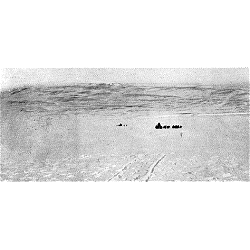| |
|
|
|
|
|
|

 |
 |
 |
Wally Herbert found a differently cropped lanternslide of this picture among Cook's photographic material donated to the Library of Congress. It shows substantial, rocky land on the right-hand margin, an impossibility at the reported position of the Glacial Island.

But how could Cook have dreamed up an ice island before any had been discovered? There were precedents. Norwegian explorer Fridtjof Nansen had mentioned in his book, Farthest North, that he passed over undulating country covered with snow far at sea. In Nearest the Pole, Peary described crossing "several large level old floes, which my Eskimos at once remarked, looked as if they did not move even in summer," and several berg-like pieces of ice discolored with sand were noted.
Many of the features and incidents described along Cook's route from his jumping off place to his Glacial Island will sound familiar to anyone who has studied the previous writings of Cook and Peary. The distortions of the sun at low altitudes and the descriptions of ice flowers forming along new ice can be found in Through the First Antarctic Night. The sudden storm on the pack ice has a close parallel in a hurricane at Annoatok described in Cook's winter diary of 1907-08. The collapse of the igloo on the arctic pack is very similar to the collapse of an igloo in 1892, as described in Peary’s Northward Over the "Great Ice", and Cook's crossing of the Big Lead shares much with Peary's description of that same accomplishment in Nearest the Pole.
| «- Bradley Land | Cook's descriptions of conditions at the Pole -» |